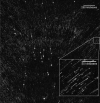Combing of genomic DNA from droplets containing picograms of material
- PMID: 25561163
- PMCID: PMC4344373
- DOI: 10.1021/nn5063497
Combing of genomic DNA from droplets containing picograms of material
Abstract
Deposition of linear DNA molecules is a critical step in many single-molecule genomic approaches including DNA mapping, fiber-FISH, and several emerging sequencing technologies. In the ideal situation, the DNA that is deposited for these experiments is absolutely linear and uniformly stretched, thereby enabling accurate distance measurements. However, this is rarely the case, and furthermore, current approaches for the capture and linearization of DNA on a surface tend to require complex surface preparation and large amounts of starting material to achieve genomic-scale mapping. This makes them technically demanding and prevents their application in emerging fields of genomics, such as single-cell based analyses. Here we describe a simple and extremely efficient approach to the deposition and linearization of genomic DNA molecules. We employ droplets containing as little as tens of picograms of material and simply drag them, using a pipet tip, over a polymer-coated coverslip. In this report we highlight one particular polymer, Zeonex, which is remarkably efficient at capturing DNA. We characterize the method of DNA capture on the Zeonex surface and find that the use of droplets greatly facilitates the efficient deposition of DNA. This is the result of a circulating flow in the droplet that maintains a high DNA concentration at the interface of the surface/solution. Overall, our approach provides an accessible route to the study of genomic structural variation from samples containing no more than a handful of cells.
Keywords: DNA deposition; DNA mapping; coffee ring effect; fiber-FISH; molecular combing; rolling droplet; single-molecule imaging.
Figures





References
-
- Neely R. K.; Deen J.; Hofkens J. Optical Mapping of DNA: Single-Molecule-Based Methods for Mapping Genomes. Biopolymers 2011, 95, 298–311. - PubMed
-
- Samad A. H.; Cai W. W.; Hu X.; Irvin B.; Jing J.; Reed J.; Meng X.; Huang J.; Huff E.; Porter B.; et al. Mapping the Genome One Molecule at a Time - Optical Mapping. Nature 1995, 378, 516–517. - PubMed
-
- Michalet X.; Ekong R.; Fougerousse F.; Rousseaux S.; Schurra C.; Hornigold N.; Slegtenhorst M. v.; Wolfe J.; Povey S.; Beckmann J. S.; et al. Dynamic Molecular Combing: Stretching the Whole Human Genome for High-Resolution Studies. Science 1997, 277, 1518–1523. - PubMed
Publication types
MeSH terms
Substances
LinkOut - more resources
Full Text Sources
Other Literature Sources

